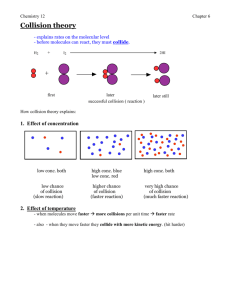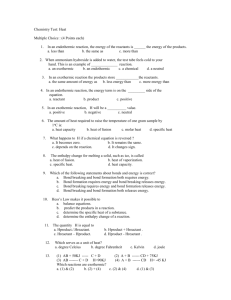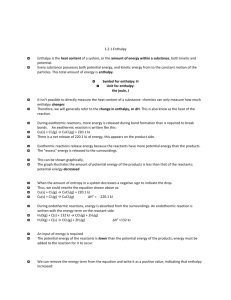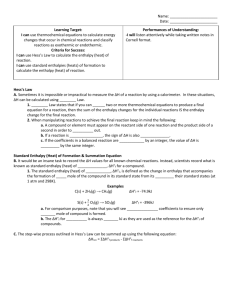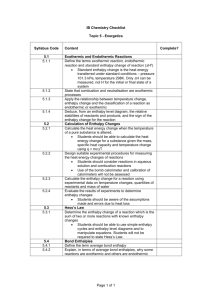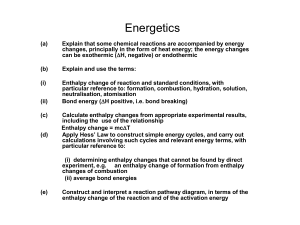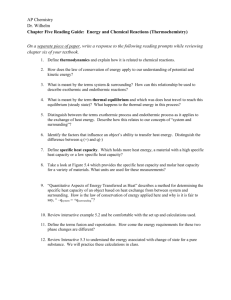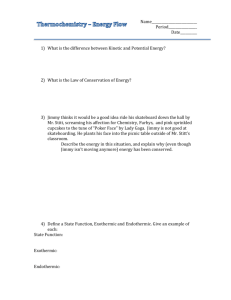CP Chem Unit 7 Review *You will get a chart for bond energies and
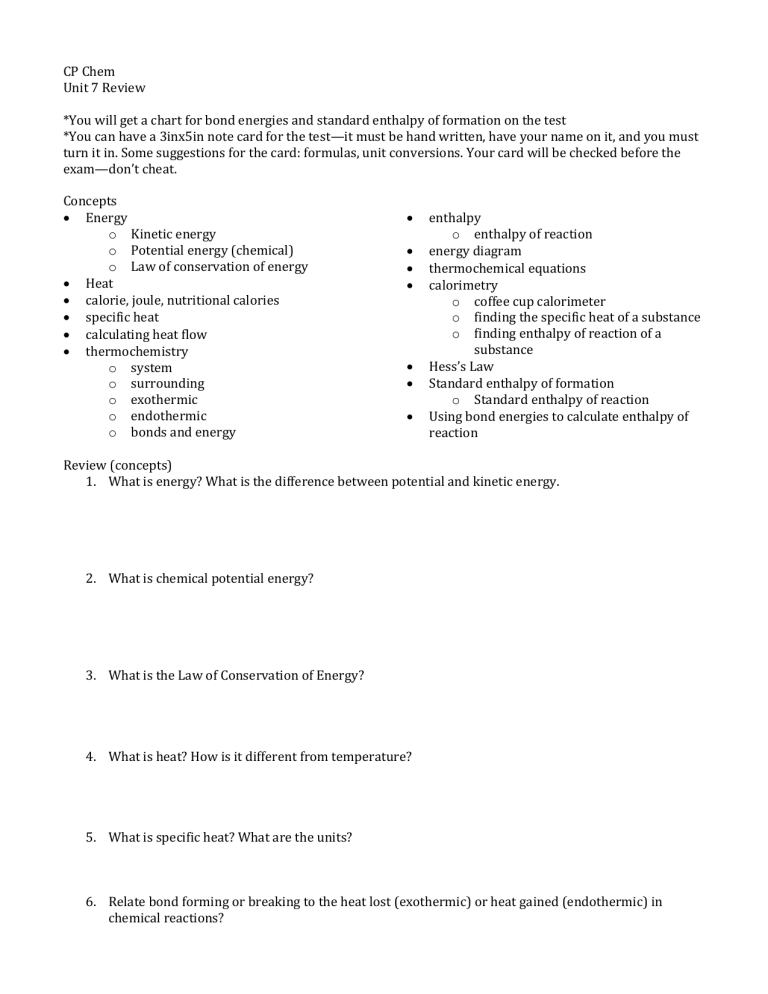
CP Chem
Unit 7 Review
*You will get a chart for bond energies and standard enthalpy of formation on the test
*You can have a 3inx5in note card for the test—it must be hand written, have your name on it, and you must turn it in. Some suggestions for the card: formulas, unit conversions. Your card will be checked before the exam—don’t cheat.
Concepts
Energy o o
Kinetic energy
Potential energy (chemical) o Law of conservation of energy
Heat
calorie, joule, nutritional calories
specific heat
enthalpy o enthalpy of reaction
energy diagram
thermochemical equations calorimetry o o coffee cup calorimeter finding the specific heat of a substance
calculating heat flow
thermochemistry o system o o o surrounding exothermic endothermic
o finding enthalpy of reaction of a substance
Hess’s Law
Standard enthalpy of formation o Standard enthalpy of reaction
Using bond energies to calculate enthalpy of o bonds and energy
Review (concepts) reaction
1.
What is energy? What is the difference between potential and kinetic energy.
2.
What is chemical potential energy?
3.
What is the Law of Conservation of Energy?
4.
What is heat? How is it different from temperature?
5.
What is specific heat? What are the units?
6.
Relate bond forming or breaking to the heat lost (exothermic) or heat gained (endothermic) in chemical reactions?
7.
How does the chemical potential energy of a system change during an endothermic reaction?
8.
In describing a chemical reaction, what is the system and what is the surrounding?
9.
What is enthalpy and enthalpy change?
10.
If H is negative, is the chemical reaction exothermic or endothermic? How has the chemical potential energy of the system changed?
11.
Draw and label an energy diagram for an endothermic reaction. Label the axis, products, reactants, activation energy, the activated complex, and H.
Review (problems—answers will be posted on my website)
12.
Use the bond energy table (in thermochem wkst #3) to determine H for this reaction. Is it exothermic or endothermic?
N
2
(g) + 3H
2
(g) 2NH
3
(g)
13.
A 4.5g nugget of pure gold absorbed 276 J of heat. What is the final temperature of the gold if the initial temperature was 25ºC? Specific heat of gold is 0.129 J/(gºC).
14.
Calculate the amount of heat produced when 20.0g of methane burns in air according to the following unbalanced equation: ___CH
4
(g) + ___O
2
(g) ____CO
2
(g) + ___H
2
O(l) H = -525kJ
15.
The temperature of an unknown metal with a mass of 18g increases from 25ºC to 40ºC when the metal absorbs 124 J of heat. What is the specific heat of the metal?
16.
A hot metal with a mass of 55g (heated to 100ºC) is placed in a coffee cup calorimeter. The temperature of 100g of water increases from 25ºC to 28.1ºC. What is the specific heat of the metal?
17.
How many joules of heat are lost by 3580 kg granite as it cools from 40°C to 10°C? C p
=.795 J/g°C
#18-21 refer to the diagram on the right.
18.
What is the ∆H of the forward reaction?
19.
What is the activation energy of the forward reaction?
20.
What is the ΔH of the reverse reaction is?
21.
The forward reaction is (endothermic or exothermic).
22.
Look at the second diagram—what does each arrow represent?
23.
Consider the combustion of methane
(unbalanced equation): ___CH
4 enthalpy of formation.
(g) + ___O
2
(g) ___CO
2
(g) + ___H
2
O(l) Calculate ºH using standard
24.
Find ΔH for this reaction: N
2
O(g) + NO
2
(g) 3NO(g)
Given: 2NO(g) + O
2
(g) 2NO
2
N
2
(g) + O
2
(g) 2NO(g) ΔH = 182.6kJ
2N
2
O(g) 2N
2
(g) + O
2
(g) ΔH = -133.1kJ
(g) ΔH=-163.2kJ
25.
Find ΔH for this reaction: PCl
3
(l) + Cl
2
(g) PCl
5
(s)
(s) ΔH = -640 kJ Given: 2P(s) + 3Cl
2
(g) 2PCl
3
2P(s) + 5Cl
2
(g) 2PCl
5
(s) ΔH = -886 kJ
26.
Find ΔºH for this reaction: CO(g) + ½O
2
(g) CO
2
(g)
Given: C(s) + ½ O
2
C(s) + O
2
(g) CO(g) ΔºH = -110.5 kJ
(g) CO
2
(g) ΔºH= -393.5 kJ
27.
Find ΔºH for this reaction: CO(g) + ½O
2
(g) CO
2
(g) using bond enthalpies.
28.
A tablespoon of sugar has 100 nutritional calories. How many calories is that? How many joules?

